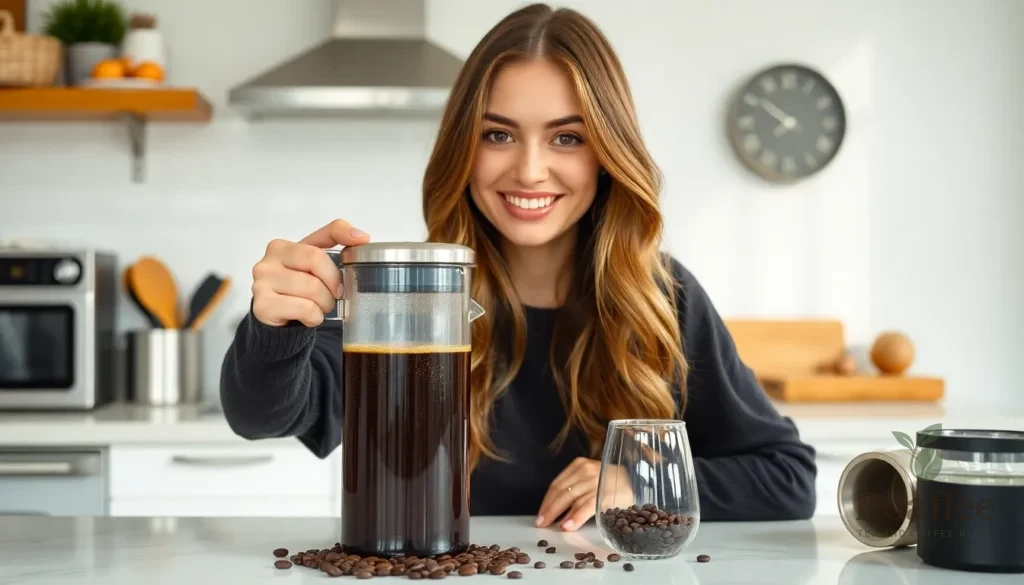We’ve all been there – standing in our kitchen wondering how to unlock the perfect cup of coffee from that mysterious cylindrical device known as a coffee press. Also called a French press, this simple yet elegant brewing method has been delivering rich, full-bodied coffee for over a century, and it’s time we master this essential skill.
The coffee press isn’t just another kitchen gadget – it’s your ticket to café-quality coffee without the hefty price tag. Unlike drip coffee makers that can strip away oils and subtle flavors, a coffee press allows the coffee grounds to steep directly in hot water, creating a robust brew that captures every nuance of your favorite beans.
We’re about to transform your morning routine with this foolproof guide that’ll have you brewing like a pro in no time. Whether you’re a coffee novice or looking to perfect your technique, we’ll walk you through each step to ensure your next cup is absolutely exceptional.
What You’ll Need
Before we jump into the brewing process, let’s gather all the essential items for making exceptional coffee press coffee. Having the right equipment and ingredients ready will ensure smooth brewing and consistent results.
Coffee Press Equipment
We recommend starting with a quality coffee press that holds between 12 to 34 ounces depending on your household size. The press should feature a sturdy glass or stainless steel carafe with a tight-fitting lid and plunger mechanism. Look for models with heat-resistant borosilicate glass that can withstand temperature changes without cracking.
The metal filter screen needs to fit snugly against the carafe walls to prevent grounds from escaping into your finished coffee. A comfortable handle makes pouring easier and safer when dealing with hot coffee. Some presses include measurement markings on the side which help with consistent water ratios.
Coffee and Water
Fresh coffee beans ground to a coarse consistency work best for press brewing. We suggest using a burr grinder to achieve uniform particle size that won’t slip through the metal filter. Medium to dark roast beans typically produce the rich flavors that coffee presses are known for.
Use filtered or spring water heated to 195-205°F for optimal extraction. The water should taste clean and neutral since any off-flavors will transfer directly to your coffee. Plan for a coffee-to-water ratio of approximately 1:15 to 1:17 depending on your strength preference.
Additional Tools
A reliable kitchen scale ensures precise measurements for consistent results every time. We find digital scales with gram measurements most accurate for coffee brewing. A timer helps track steeping time which directly affects flavor extraction.
A wooden or plastic stirring spoon prevents scratching the glass carafe while mixing grounds and water. Keep a kitchen towel nearby for cleanup since coffee presses can be messy during the pressing process. A separate carafe or thermal server helps keep your coffee warm if you’re not drinking it immediately.
Ingredients
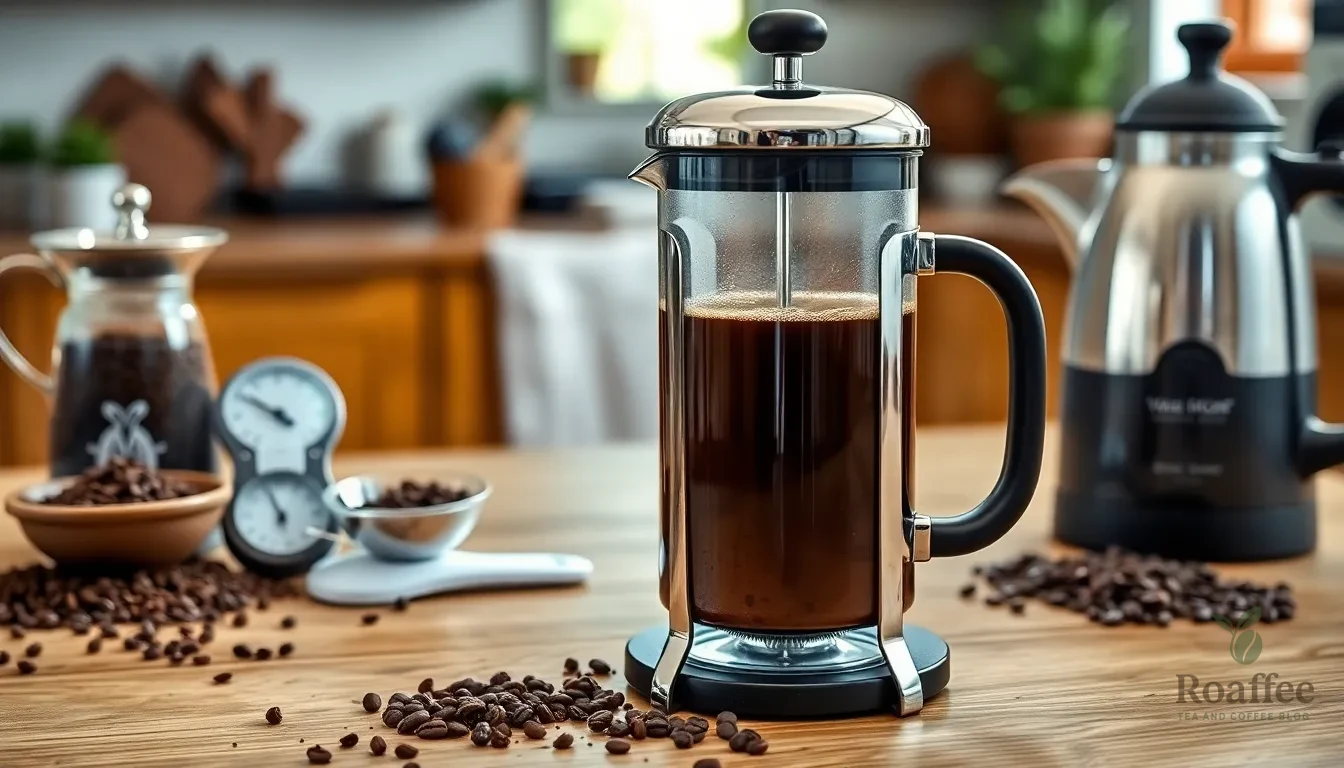
Now that we’ve covered the essential equipment, let’s focus on the precise ingredients needed to create our perfect coffee press brew. The beauty of French press coffee lies in its simplicity, requiring just two main components that work together to deliver exceptional flavor.
Coffee Requirements
We recommend using 1 ounce (30-40 grams) of coarse ground coffee for every 16 ounces of water. This 1:16 coffee-to-water ratio ensures optimal extraction without overwhelming bitterness. Fresh grinding produces the best results, as pre-ground coffee loses its aromatic oils quickly.
| Measurement | Coffee Amount | Water Amount |
|---|---|---|
| Standard Ratio | 1 oz (30-40g) | 16 oz (700ml) |
| Small Batch | 0.5 oz (15-20g) | 8 oz (350ml) |
| Large Batch | 2 oz (60-80g) | 32 oz (1400ml) |
The grind size should resemble coarse sand rather than fine powder. Coarse grounds prevent clogging the metal filter and reduce the risk of bitter over-extraction. We avoid fine grounds as they slip through the filter screen and create sediment in our final cup.
Water Specifications
Our water temperature should reach 200-205°F, which is just off the boiling point. This temperature range allows for proper extraction of coffee oils and flavors without scalding the grounds. We use filtered water whenever possible to eliminate chlorine and other impurities that can interfere with taste.
Measuring water accurately ensures consistency across multiple brewing sessions. We heat slightly more water than needed to account for preheating the French press carafe, which helps maintain optimal brewing temperature throughout the process.
Preparation Steps
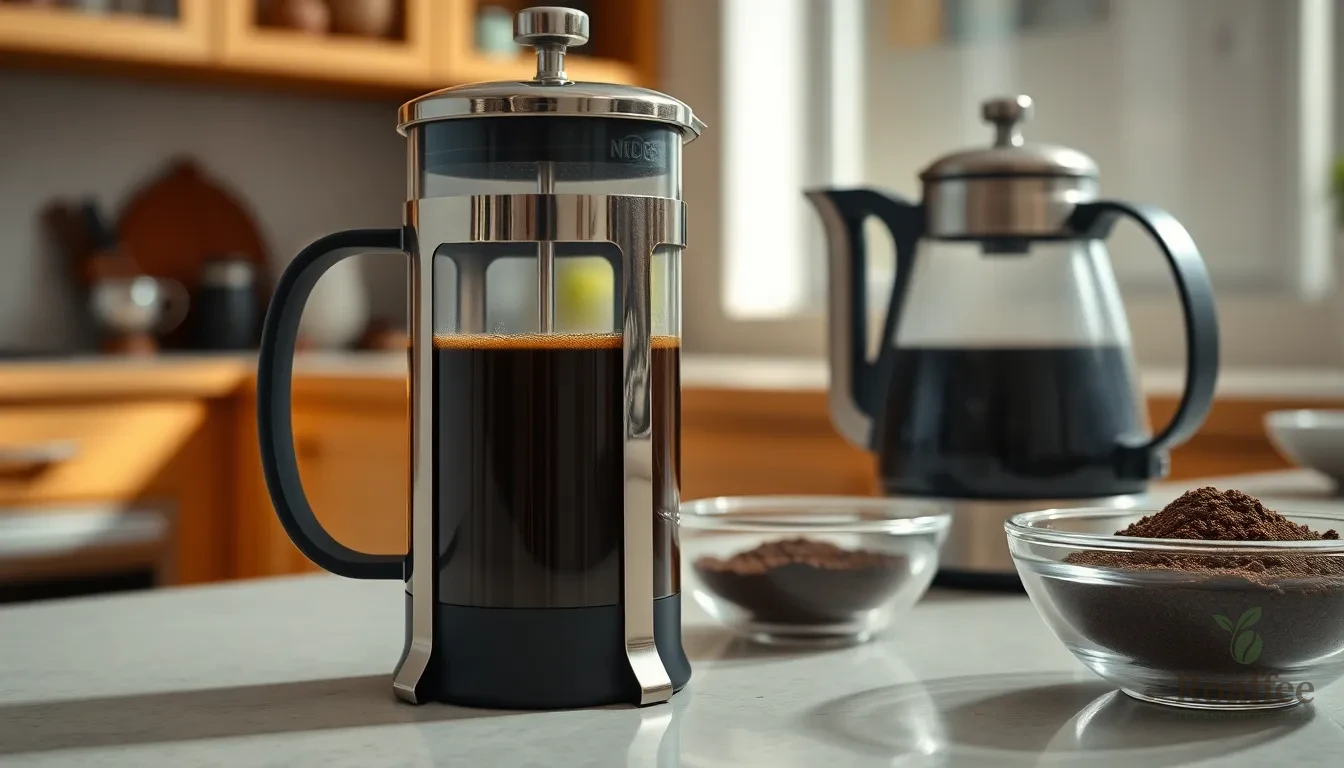
Before we begin brewing our coffee press coffee, we need to complete three essential preparation steps. These initial steps ensure optimal extraction and temperature control for the perfect cup.
Heating the Water
We start by heating our water to the ideal temperature range of 200-205°F. Bring water to a rolling boil then let it sit for 30 seconds to reach this optimal brewing temperature. This temperature range allows for proper extraction without scorching the coffee grounds. Using a thermometer ensures precision but watching for the water to just stop bubbling vigorously serves as a reliable visual cue.
Measuring Coffee Grounds
We measure approximately 1 heaping tablespoon or 11 grams of whole bean coffee per cup of water we plan to brew. Our coffee should be ground to a coarse consistency that resembles coarse sea salt. This grind size prevents the grounds from passing through the metal filter while allowing proper water flow. Using a kitchen scale provides the most accurate measurement for consistent results every time.
Preheating the Press
We pour boiling water into our empty French press to warm the entire brewing chamber. This step maintains the water temperature throughout the brewing process and prevents heat loss. After 30 seconds we discard this warming water completely. The preheated press ensures our brewing water stays at the optimal temperature range during the entire steeping process.
Instructions
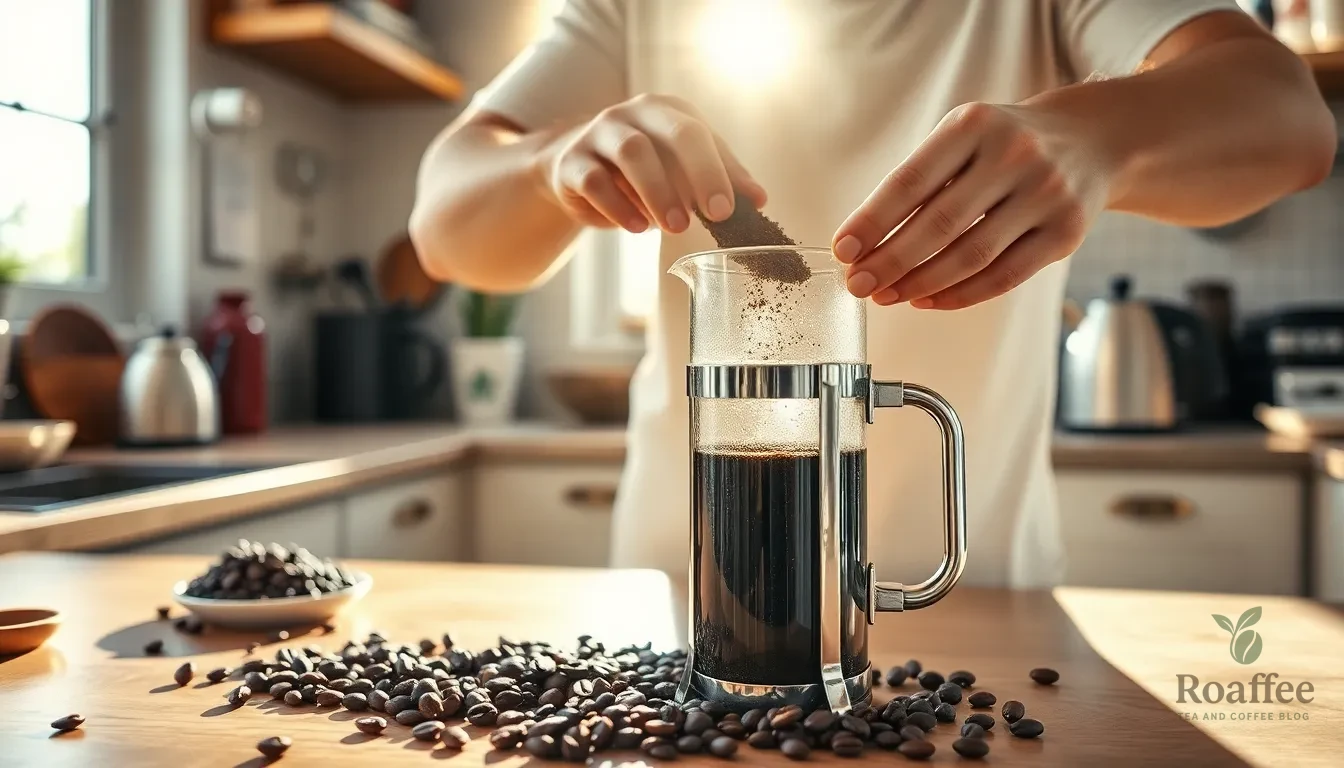
Now that we have our equipment and ingredients ready, let’s walk through the step-by-step brewing process to create the perfect cup of coffee press coffee.
Adding Coffee to the Press
We begin by placing our coarsely ground coffee beans into the empty French press. The grind should resemble coarse sand to avoid clogging the filter and ensure proper extraction. For a full 4-cup press, we measure about 11 tablespoons of coffee grounds or adjust based on our preferred strength. This coarse grind size is crucial for preventing grounds from passing through the metal filter and creating a clean final cup.
Pouring Hot Water
We pour our hot water at 200-205°F in two stages for optimal extraction. First, we add a small amount of hot water (about half of our total water) evenly over the coffee grounds to bloom them. This blooming process releases CO2 and enhances flavor development. After letting the coffee bloom for about 30 seconds, we pour the remaining hot water into the press to complete the brewing process.
Stirring the Coffee
We give the coffee a gentle stir after the blooming phase to break up the crust of grounds that forms on top. This stirring helps mix the grounds evenly with water and ensures uniform extraction. We avoid stirring too vigorously to prevent bitterness from developing. Once we complete the gentle stirring, we’re ready to move to the steeping phase.
Steeping Time
We place the lid on the press with the plunger pulled all the way up and let the coffee steep for about 4 minutes. Some coffee enthusiasts prefer 3-6 minutes depending on their strength preference. After the steeping time completes, we slowly press the plunger down to separate the grounds from the coffee. We pour the coffee immediately into our mug to avoid over-extraction and bitterness that can develop from prolonged contact with the grounds.
Pressing and Serving
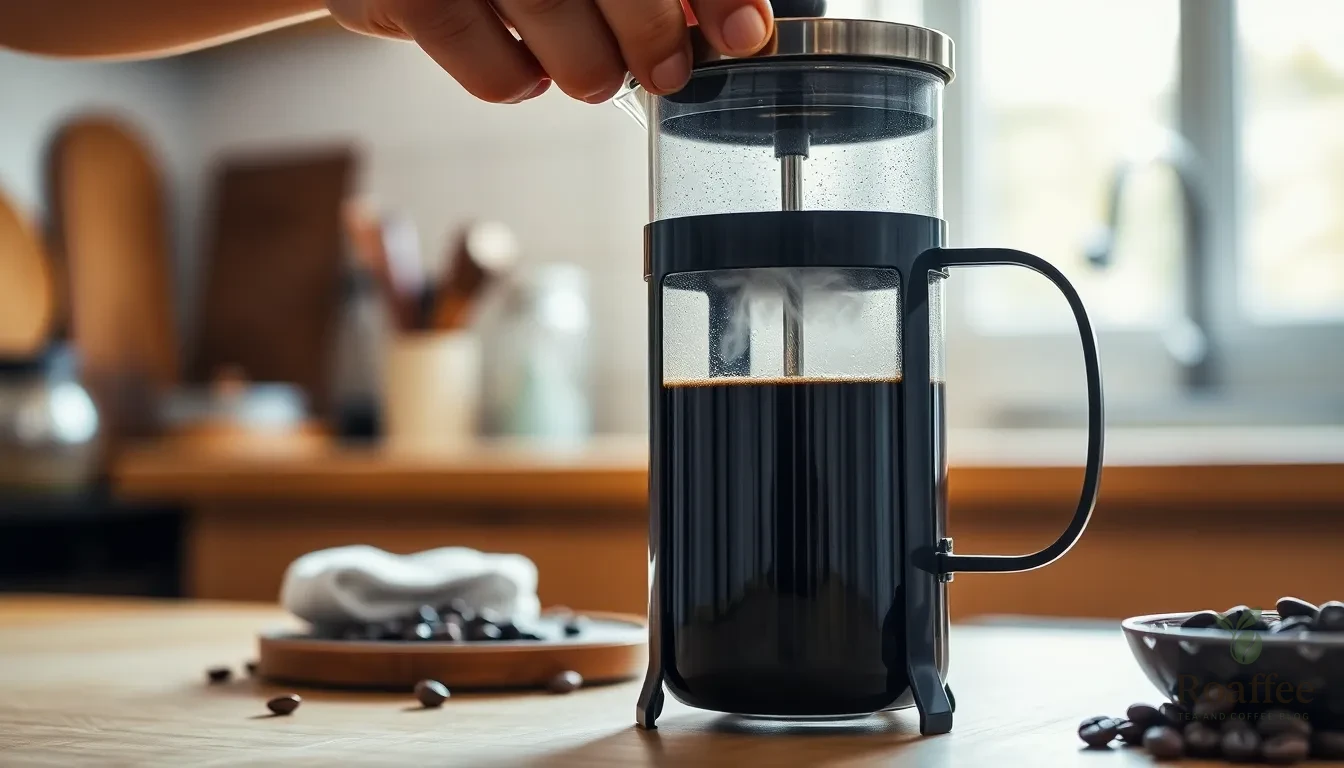
After our coffee has steeped for 4 minutes, we move to the critical final steps that determine the quality of our brew. The pressing and serving technique separates exceptional coffee from mediocre results.
The Pressing Technique
We begin by placing the lid with the plunger pulled all the way up on our coffee press. The key to successful pressing lies in our technique – we must press the plunger down slowly and gently to separate the brewed coffee from the grounds effectively.
Pressing too quickly causes grounds to escape into our coffee, creating an unpleasant gritty texture. Our goal is to push the grounds cleanly to the bottom while filtering the liquid above for a smooth cup. We apply steady, even pressure throughout the pressing motion to ensure optimal separation.
The plunger should move downward in one continuous motion without forcing or rushing the process. This controlled approach prevents the metal filter from becoming overwhelmed and maintains the integrity of our brewing method.
Serving Immediately
Once we have fully pressed the plunger down, we pour the coffee into our cups immediately. Timing becomes crucial at this stage because leaving the coffee in the French press with the grounds leads to over-extraction and unwanted bitterness.
Continued contact between the brewed coffee and grounds compromises the flavor balance we worked to achieve during the steeping process. We preserve the coffee’s fresh flavor and optimal balance by serving right away rather than allowing it to sit in the press.
Our immediate serving approach captures the rich, aromatic qualities typical of the French press brewing style. This method ensures we enjoy the full-bodied flavor profile that makes coffee press brewing so distinctive and rewarding.
Tips for Perfect Coffee Press Results
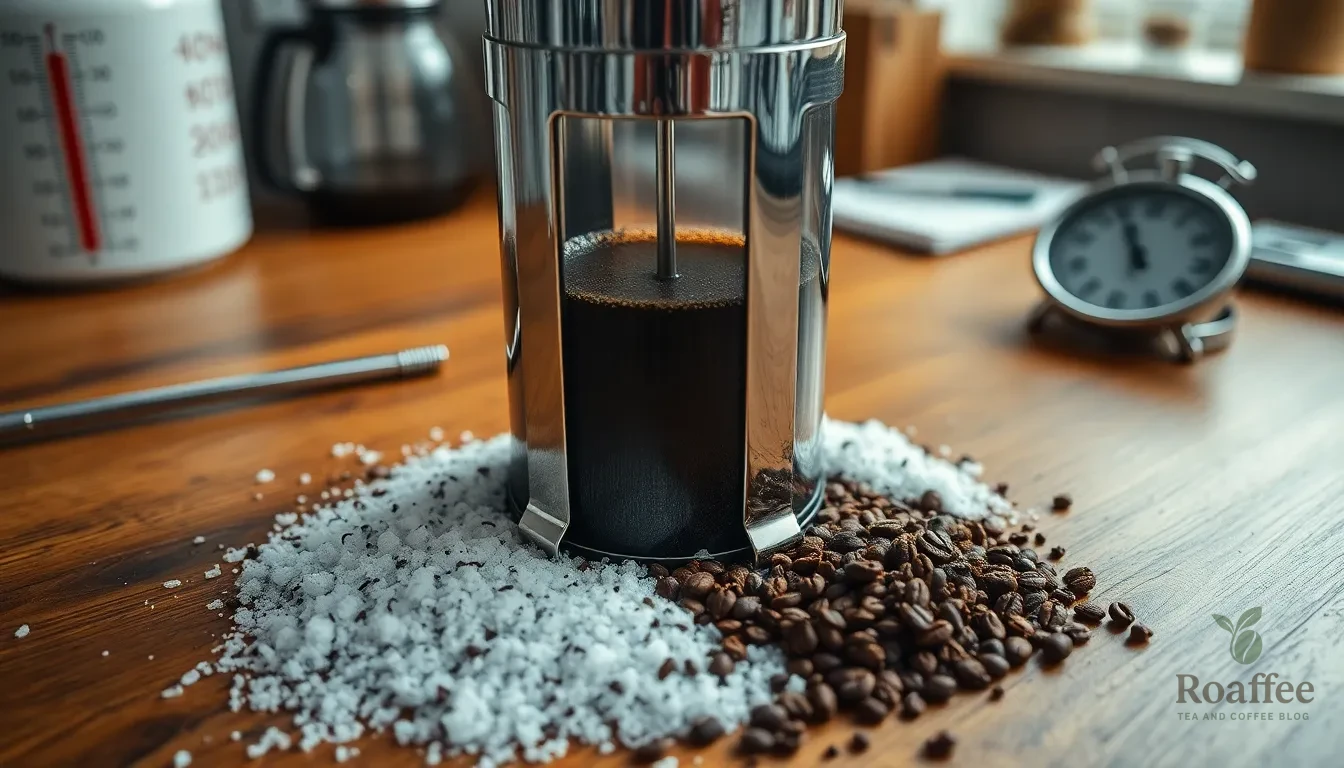
Now that we’ve covered the brewing process, let’s focus on the critical elements that separate good coffee press results from exceptional ones. These professional techniques will help you achieve consistently delicious coffee every time.
Grind Size Matters
We cannot stress enough how crucial the proper grind size is for coffee press success. Use coarsely ground coffee that resembles coarse salt or steel-cut oats in texture. This coarse grind prevents clogging the metal filter and ensures proper extraction without over-brewing.
Finely ground coffee leads to over-extraction and creates an unpleasantly bitter cup. The larger particles also make pressing the plunger much easier and reduce sediment in your final brew. We recommend grinding your beans just before brewing to maintain maximum freshness and flavor.
Water Temperature Guidelines
Achieving the perfect water temperature transforms your coffee press results dramatically. Heat water to approximately 200-205°F for optimal extraction without scalding the coffee grounds. This temperature range sits just below boiling point and extracts the best flavors from your beans.
After bringing water to a full boil, let it cool for about 30 seconds to reach this ideal temperature. Water that’s too hot burns the coffee and creates bitter notes, while water that’s too cool results in weak, under-extracted coffee. We find this temperature sweet spot consistently produces rich, balanced flavors.
Timing Is Everything
Mastering the timing elements of coffee press brewing ensures perfect extraction every time. Start with a 30-second bloom period after adding half the hot water to the grounds. This allows the coffee to release gases and expand, creating better flavor development.
After the bloom, stir gently to break the crust, add the remaining water, and steep for exactly 3.5 to 4 minutes total. This timing prevents over-extraction while ensuring full flavor development. Press the plunger down slowly and serve immediately to avoid bitterness from continued steeping.
Cleaning and Maintenance
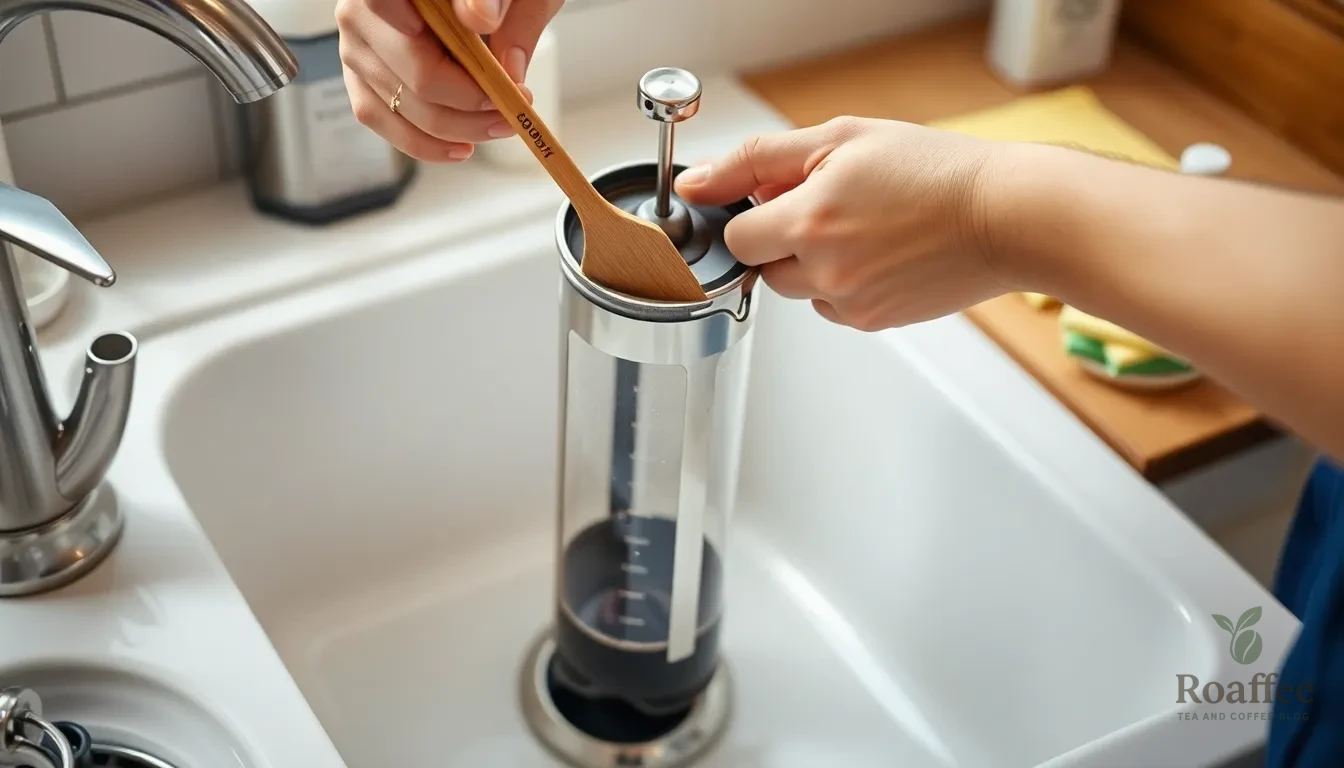
Proper maintenance of your coffee press ensures optimal flavor extraction and extends the lifespan of your brewing equipment. We’ll guide you through both daily cleaning routines and periodic deep cleaning methods to keep your French press in pristine condition.
Immediate Cleaning
Daily cleaning after each use prevents oil buildup and maintains the quality of your coffee. We recommend starting the cleaning process immediately after serving to prevent grounds from hardening and oils from becoming difficult to remove.
Remove the used coffee grounds using a wooden or plastic spatula rather than metal utensils to avoid scratching the glass carafe. Rinse all components thoroughly with warm water to eliminate residual grounds from the plunger assembly and filter screen.
Add a small amount of liquid dish soap with degreasing power to the carafe and fill it halfway with hot water. Insert the plunger and perform several plunging motions to clean coffee oils from all surfaces and components.
Rinse all parts thoroughly with clean water to remove soap residue that could affect future brews. Air dry the components completely or use a lint-free cloth for immediate drying while avoiding paper towels that leave fibers.
Deep Cleaning Steps
Weekly deep cleaning maintains your coffee press performance and prevents stubborn residue buildup. We recommend fully disassembling the plunger mechanism to access all filter components and internal surfaces.
Soak all removable parts in warm soapy water for 15-20 minutes to loosen accumulated coffee oils and mineral deposits. Scrub gently with a soft brush to remove any persistent residue without damaging the metal filter screen.
| Component | Soaking Time | Scrubbing Method |
|---|---|---|
| Filter Screen | 15-20 minutes | Soft brush |
| Plunger Assembly | 15-20 minutes | Gentle circular motions |
| Carafe | 10-15 minutes | Soft cloth |
Rinse each component thoroughly with clean water and inspect the filter screen for any remaining particles. Reassemble the plunger mechanism carefully and perform a test plunge with water to ensure smooth operation before your next brewing session.
Troubleshooting Common Issues
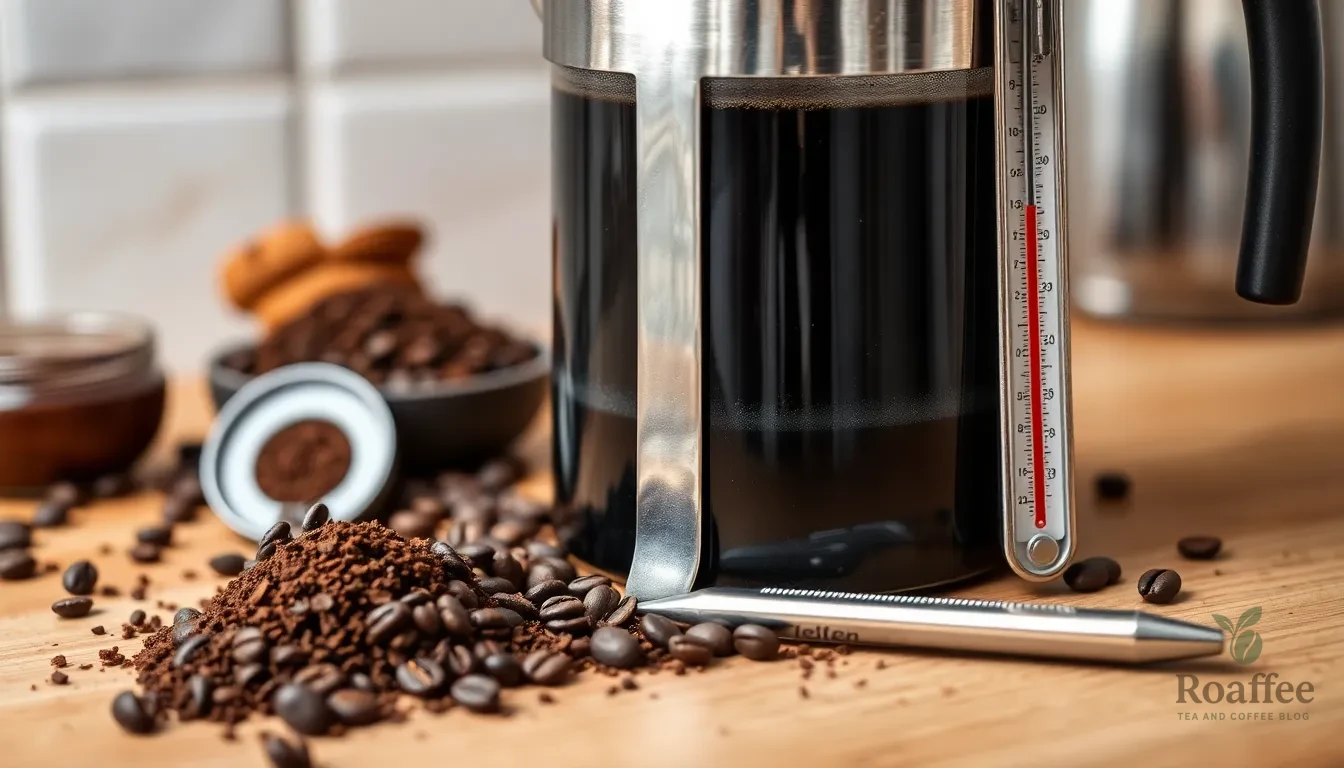
Even experienced coffee enthusiasts encounter brewing challenges with their coffee press. We’ve compiled the most common problems and their answers to help you achieve consistently excellent results every time.
Bitter or Harsh Tasting Coffee
Our most frequent complaint involves coffee that tastes overly bitter or harsh. This problem typically stems from two main causes: using grounds that are too fine or allowing the coffee to brew for too long. Fine grounds create over-extraction and can clog your filter, while extended brewing times pull out undesirable compounds from the coffee beans.
We recommend switching to a coarser grind that resembles coarse sea salt. Also, limit your steep time to exactly 4 minutes to prevent over-extraction. Water temperature also plays a crucial role – brew between 195-205°F, with lighter roasts near 205°F and darker roasts closer to 195°F.
Weak or Under-Extracted Coffee
Coffee that tastes weak or watery indicates under-extraction. This issue occurs when your grind is too coarse or your brewing time is insufficient. The water doesn’t have enough contact time with the coffee grounds to extract the full range of flavors.
Adjust your grind to be slightly finer while maintaining a coarse texture. Brew closer to 4 minutes or extend the steeping time by 30 seconds if you prefer stronger coffee. Water quality directly affects your coffee’s taste, so ensure you’re using good-tasting filtered water.
Coffee Grounds in Your Cup
Finding sediment or grounds in your finished coffee is a common French press characteristic. Unlike paper filters, the metal mesh screen allows some fine particles to pass through. This natural occurrence becomes more noticeable with improperly sized grounds.
Use a consistently coarse grind to minimize sediment. We suggest employing the “sediment trick”: just before plunging, skim any floating grounds from the surface using two spoons. This simple technique removes excess particles that would otherwise end up in your cup.
Off Flavors and Strange Tastes
Poor water quality creates off flavors that no brewing technique can overcome. Municipal water with high chlorine content or mineral deposits affects your coffee’s taste profile significantly.
Switch to filtered or bottled water for brewing. The quality of your water directly impacts your final cup, so invest in good-tasting water for optimal results.
| Issue | Primary Cause | Solution |
|---|---|---|
| Bitter taste | Fine grind or over-brewing | Coarser grind; 4-minute steep limit |
| Weak coffee | Coarse grind or short brew time | Slightly finer grind; full 4-minute brew |
| Grounds in cup | Natural sediment from metal filter | Coarse grind; skim floating grounds |
| Off flavors | Poor water quality | Use filtered or bottled water |
| Too hot coffee | Excessive water temperature | Brew at 195-205°F range |
Temperature Issues
Coffee that’s too hot or burns your tongue indicates water temperature problems. Boiling water creates harsh, bitter flavors and can damage delicate coffee compounds.
Allow your boiling water to sit for 30 seconds before brewing to reach the optimal 200-205°F range. This temperature provides proper extraction without scorching the grounds. Different roast levels require slight temperature adjustments for best results.
These troubleshooting answers address the most common coffee press problems we encounter. Implementing these adjustments will help you consistently brew balanced, flavorful coffee that showcases your beans’ best characteristics.
Conclusion
We’ve walked you through every aspect of mastering the coffee press from selecting the right equipment to troubleshooting common issues. With these techniques in your toolkit you’ll consistently brew rich flavorful coffee that rivals any café.
The beauty of the coffee press lies in its simplicity and the control it gives you over your brewing process. By focusing on quality ingredients proper timing and gentle technique you’ll transform your daily coffee routine into something truly special.
Remember that practice makes perfect. Don’t be discouraged if your first few attempts aren’t exactly what you’re hoping for. Each cup is an opportunity to refine your skills and discover your personal preferences for the ultimate coffee press experience.
Frequently Asked Questions
What is a coffee press and how does it work?
A coffee press, also known as a French press, is a simple brewing device that steeps coarse coffee grounds in hot water for about 4 minutes. It features a cylindrical carafe with a metal filter plunger that separates the brewed coffee from the grounds. This method preserves the natural oils and flavors of coffee beans, producing a rich, full-bodied cup.
What coffee-to-water ratio should I use for coffee press brewing?
Use a ratio of 1 ounce (30-40 grams) of coarse ground coffee for every 16 ounces of water. For a standard 4-cup press, this equals approximately 11 tablespoons of coffee grounds. This ratio ensures optimal extraction and balanced flavor without over-extraction or weakness.
What grind size is best for coffee press brewing?
Use a coarse grind that resembles coarse sea salt or breadcrumbs. This grind size prevents clogging of the metal filter and ensures proper water flow during extraction. Avoid fine grinds as they can pass through the filter and create a gritty texture in your coffee.
What water temperature should I use for coffee press brewing?
Heat water to 200-205°F for optimal extraction. If you don’t have a thermometer, bring water to a boil and let it sit for 30 seconds before pouring. This temperature range extracts the best flavors from coffee grounds without creating bitterness from over-extraction.
How long should I steep coffee in a French press?
Steep coffee for 4 minutes total. Start with a 30-second bloom by pouring a small amount of hot water over the grounds, then add the remaining water and steep for 3.5 more minutes. This timing ensures proper extraction without over-steeping, which can cause bitterness.
Why is my coffee press coffee bitter or harsh?
Bitter coffee usually results from over-extraction caused by too fine a grind, water that’s too hot (above 205°F), or steeping too long. Try using a coarser grind, reducing steeping time to 3.5-4 minutes, or letting boiling water cool for 30 seconds before brewing.
How do I prevent coffee grounds from ending up in my cup?
Use a coarse grind and press the plunger down slowly and gently. Don’t force the plunger or press too quickly, as this can push grounds through the filter. Ensure your metal filter screen fits snugly and isn’t damaged or warped.
How should I clean my coffee press?
Daily: Remove grounds with a wooden spatula, rinse with warm water, and wash with degreasing dish soap. Weekly: Disassemble removable parts and soak in warm soapy water, then gently scrub to remove oil residue. Proper cleaning maintains optimal flavor and extends your press’s lifespan.
Can I use pre-ground coffee in a coffee press?
While fresh-ground coffee is preferred for maximum flavor, you can use pre-ground coffee if it’s coarsely ground. However, freshly ground beans retain more aromatic oils and produce better flavor. If using pre-ground, ensure it’s specifically labeled for French press or coarse grind.
Should I preheat my French press before brewing?
Yes, preheating helps maintain optimal brewing temperature throughout the steeping process. Pour boiling water into the empty press, swirl it around, then discard the water before adding your coffee grounds. This simple step prevents temperature loss during brewing.

